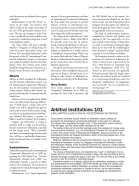 FOR MOST LARGE COMPANIES involved in cross-border contracts, International Commercial Arbitration is the preferred means of dispute resolution, due to the certainty that arbitration agreements will be respected by domestic courts and awards will be enforceable. With the exceptions of Ontario and Québec, however, the Canadian provinces have arguably failed to keep their statutes relating to International Commercial Arbitration up to date compared to other jurisdictions that companies might choose.
FOR MOST LARGE COMPANIES involved in cross-border contracts, International Commercial Arbitration is the preferred means of dispute resolution, due to the certainty that arbitration agreements will be respected by domestic courts and awards will be enforceable. With the exceptions of Ontario and Québec, however, the Canadian provinces have arguably failed to keep their statutes relating to International Commercial Arbitration up to date compared to other jurisdictions that companies might choose.The key legal instrument is the New York Convention on the Recognition and Enforcement of Foreign Arbitral Awards, to which Canada has been a party since 1986. The New York Convention requires that contracting states give effect to private agreements to arbitrate disputes, and to recognize and enforce arbitral awards on a reciprocal basis with other contracting states.
The United Nations Commission on International Trade Law (UNCITRAL)’s Model Law on International Commercial Arbitration complements the Convention. It is an archetype law that can be adopted domestically by states in order to harmonize legal regimes governing International Commercial Arbitration across jurisdictions. Under the Model Law, says Pierre Dalphond, a senior counsel at Stikeman Elliott LLP in Montréal and former senior judge of the Québec Court of Appeal, “International Commercial Arbitration is a completely independent system.
“The final award cannot be reviewed by a court of law on either a question of law or of fact. There are very limited grounds pursuant to which you can have an award set aside or, if the award is rendered in another country, have the Canadian court refuse to enforce it.”
Sarah Armstrong, a partner at Fasken Martineau DuMoulin LLP in Toronto, says two recent cases — Sattva Capital v. Creston Moly (2014 SCC 53) and Novatrax International v. Hägele Landtechnik (2016 ONCA 771) — confirm “that in our legal system, our courts take very seriously the rights of parties to have their disputes adjudicated outside of court, and they’ll respect that decision of the parties.”
So whether it is a matter of decisions limiting the scope of rights of appeal (Sattva) or limiting the ability of parties to go to court when they originally agreed to arbitration (Novatrax), “outsiders looking at our system would generally read these decisions as being supportive of a system that respects arbitration and parties’ agreement to arbitrate,” says Armstrong.
In recent years, the Uniform Law Conference of Canada (ULCC) has been encouraging the provinces and territories to harmonize their International Commercial Arbitration statutes on the basis of the UNCITRAL Model Law, 2006 version. “It is important to Canada’s continued success in presenting itself to foreign users that as far as possible the provinces and territories implement international arbitration legislation that is uniform in both form and substance, as a diversity of approaches among jurisdictions within Canada may deter foreign users,” said the ULCC Report of the Working Group on New Uniform Arbitration Legislation, issued in 2014.
If the laws were to be harmonized among provincial and territorial jurisdictions, “Canada in general would become a more attractive space for International Arbitration,” says Shara Roy, a partner at Lenczner Slaght Royce Smith Griffin LLP in Toronto.
Harmonization sends the right signals to the rest of the world, says Dalphond. “Parties want to have a seat which is neutral, efficient and where the courts won’t mingle with the process. We are not big players on the world stage in this compared to New York, Paris, London or even Stockholm. Canada is now trying to position itself. It’s worthwhile doing, but we should have done it before. Canada has a niche: we’re bilingual and bi-juridical, with both common law and civil law.”
However, Craig Dennis, a partner at Dentons Canada LLP in Vancouver, says harmonization need not be a high priority. “I’m not sure uniformity among the Canadian jurisdictions is a huge factor in deciding on Vancouver or Toronto as a venue for International Commercial Arbitration.” Armstrong agrees: “It doesn’t seem to me to be one of the very pressing areas where we could use harmonization, like the securities laws, for example.”
ONTARIO
Ontario is the province that has most recently updated its legislation governing International Commercial Arbitration. The current iteration of its International Commercial Arbitration Act came into force on March 22, 2017, replacing the one in force since 1990. The purpose of the legislation is to set basic norms for the ways in which International Commercial Arbitrations are conducted in Ontario as well as the treatment of resulting arbitral awards by Ontario courts. In essence, Ontario’s new ICAA appends both the New York Convention and the 2006 Model Law.
The Alberta government has also appended the Convention and the 1985 Model Law to its statute. British Columbia and Québec, in contrast, have taken provisions from the Convention and the Model Law and incorporated them into their statutes, sometimes amending the provisions in the process. “I see the Ontario and Alberta approach as less complicated and potentially more appealing to outsiders coming in,” says Armstrong.
Ontario’s approach facilitates matters by showing that which is included and not, without having to do a line-by-line comparison between the provincial legislation and the international regime, says Roy. “That already gave Ontario an advantage, and this [new legislation] enhances it.”
The new ICAA clarifies some ambiguities in the old Act that had resulted in disputes and uncertainty. First, the ICAA, 2017 explicitly states that the Convention and the Model Law have “force of law in Ontario.” The ICAA, 1990 had made no reference to the Convention. So Ontario was the only Canadian jurisdiction without legislation that explicitly incorporated the New York Convention.
“Previously,” says Roy, “it was inferred that the New York Convention was applicable in Ontario by virtue of section 10 of the previous version of the Ontario Act, which said that an arbitral award includes an award made outside of Canada. Now the new legislation formally removes any doubt that Ontario is a New York Convention jurisdiction, to the extent that any existed previously.”
Whether the specific provisions of the New York Convention were applicable in Ontario was a matter of debate. “Most of the time that debate was resolved in favour of ‘yes,’ but now there’s just no room for debate,” says Roy. Ontario’s Superior Court of Justice can apply the Convention as part of Ontario law when a party seeks to enforce, or resist enforcement of, an international arbitral award.
Secondly, by appending the 2006 Model Law, the new Ontario Act modernizes the definition of an “arbitration agreement.” Previously it required that an arbitration agreement be explicitly in writing to be enforceable. Now, a written agreement is deemed to exist as long as the content of the agreement is “recorded” in some form.
Says Roy: “It could be recorded in correspondence, in electronic communication, or it may even be that if a party pleads it and the other party doesn’t deny it, that may be sufficient. It really broadens the scope of what may be available for international commercial arbitration.”
Thirdly, the ICAA, 2017 clarifies the scope and availability of interim relief from an arbitration tribunal. A party to an arbitration may seek interim relief if it suspects, for example, that the other party is going to dissipate the asset in dispute or destroy evidence. The old Act, based on the 1985 Model Law, allowed tribunals to grant interim relief, but was not specific about the scope of the relief available. Parties would sometimes appeal to the court before or during a proceeding because of the uncertainty. The 2006 Model Law established a comprehensive interim measures regime.
The ICAA, 2017 expressly recognizes a tribunal’s power to grant interim measures, including an injunction and security for costs, and for those orders to be recognized and enforced as binding by Ontario’s Superior Court of Justice.
Finally, the new Act sets a limitation period of 10 years for enforcing an arbitral award, from the date the award is made or the date on which a proceeding to set aside the award is concluded.
Previously the limitation period was two years. This change provides needed clarity following the Supreme Court of Canada’s 2010 ruling in Yugraneft Corp. v Rexx Management (2010 SCC 19), in which the SCC held that local limitations laws also applied to the enforcement of an arbitral award, absent an express provision in the relevant legislation to the contrary.
Even if the 10-year limitation period for enforcement of foreign arbitral awards were harmonized among all the provinces, a victorious party might still have to seek enforcement in several provinces. “But they would have a longer period of time to understand whether it was a commercially reasonable course of action,” says Roy. “Two years doesn’t give a party much time to collect themselves, retain counsel and start pursuing assets in different provinces in Canada.”
While the new Act is intended to promote Ontario as a seat for International Arbitrations, at the very least it will ensure that Ontario remains an arbitration-friendly jurisdiction that favours harmonized legal standards for recognition and enforcement of international arbitral law.
Recent case law in the province included Covanta v Barton-Marlow et al. (2016 ONSC 2044). The arbitrator had added parties to the arbitration at the request of another party, and the court found that this was beyond the arbitrator’s jurisdiction. The subcontractors were not parties to the arbitration agreement but to a supplemental agreement; they thus could not be bound by an arbitral award. The court removed these added parties and referred the agreement to arbitration again.

SIDEBAR: Arbitral Institutions 101
A well-written clause is crucial for determining the process.
QUÉBEC
Unlike the common-law provinces, Québec’s civil law has one integrated statute for domestic and International Arbitration. In 1996, Québec replaced the chapter on Arbitration in its Code of Civil Procedure with provisions based on UNCITRAL’s 1985 Model Law, making more or less the same rules applicable to both domestic and international arbitration in the province.
Québec, in contrast to the common-law provinces, considers an arbitration to be “international” if at least one of the parties to the dispute is headquartered outside Québec, even if it is in, say, British Columbia or Ontario. (In the other provinces, it would be considered a domestic arbitration and subject to the separate domestic arbitration statute.)
Says Dalphond: “You have more, in a sense, International Arbitration in Québec, because each time I have a case involving a company from Ontario or one from BC, it’s an International Arbitration, according to the concepts used in Québec. But it doesn’t matter because in Québec, Interprovincial and International Arbitrations are governed by the same set of rules.”
A new Code of Civil Procedure, which came into force in Québec in January 1, 2016, contains a chapter that reflects the 2006 Model Law. “The 2006 Model Law was taken in substance and codified in the larger Code of Civil Procedure, but with some changes in wording,” says Dalphond. “But you don’t find the Model Law attached to the Code of Civil Procedure.”
One significant deviation from the Model Law contained in the Code is the default clause for the composition of the arbitration panel. It stipulates that, for resolving disputes in which the amount claimed is less than US$2 million, there will be one arbitrator unless the parties have agreed to have more. The Model Law provides for a panel of three arbitrators unless the parties have agreed otherwise.
The reason for this deviation was to make the arbitration process faster and less expensive. This reflects a shift in the rules of the major International Arbitration institutions. However, when major contracts are in dispute, says Dalphond, most parties will prefer to have three panelists rather than have their fate consigned to a single arbitrator. “Three can make a mistake, but the risk is reduced.”
Québec should advertise itself around the world as the perfect legal seat for International Commercial Arbitration, he says. “We’re common law in the process and civil law in the reasoning. We’re between Europe and the US, if you need a neutral spot with good access.”
BRITISH COLUMBIA
BC’s International Commercial Arbitration Act is based on the original version of the Model Law, says Dentons’ Craig Dennis. “It’s pretty faithful to the 1985 Model Law; it doesn’t spell out all aspects in as much detail, but the concepts are there.”
Under BC’s former Liberal government, a working group was created to update the statute and thereby make Vancouver a more attractive seat of International Commercial Arbitration. One of the key provisions to be addressed in any update of the BC legislation would be the 2006 Model Law’s evolution in the area of interim relief and what powers an arbitrator has to grant such relief.
Modernization of the BC statute “remains on the table,” says Dennis, “but where it falls on the range of priorities of the new NDP government remains to be seen.” He says any strategy to make Vancouver a preferred seat must include an educational or marketing component as well as the legislative update.
“An Asian client will more naturally default to Singapore or Hong Kong, because they know those places better, says Dennis. His “anecdotal impression” is that the growth of the BC International Commercial Arbitration Centre in Vancouver as an arbitral institution has been less than hoped. “Even the Centre’s name maybe should be changed because Vancouver, as a brand, is better known in Asia than is BC.”
ALBERTA
Alberta in 2000 amended the Arbitration Act, for domestic arbitration matters, and the International Commercial Arbitration Act, for International Commercial Arbitration matters. Alberta, like Ontario, appends to the latter the Convention and the Model Law.
However, it has not updated the Model Law to its 2006 version from the 1985 version. “I think there’s a chance [the newer Model Law will be adopted] but government tends to move slowly in these things, not only in our jurisdiction but elsewhere,” says Michael McCachen, a partner at Blake, Cassels & Graydon LLP in Calgary.
Calgary, says McCachen, is trying to promote itself as a legal seat for International Commercial Arbitration, especially for the energy sector. “We’ve personally seen that convincing foreign investors that they will have a predictable dispute-resolution mechanism here in Canada is very important.”
SASKATCHEWAN
Saskatchewan proclaimed its International Commercial Arbitration Act in 1988, appending the 1985 Model Law. “It hasn’t substantively changed since 1988,” says Christopher Masich, a partner at McKercher LLP in Saskatoon. He is unaware of any plans by the Saskatchewan government to update its statute.
Saskatchewan is an “export-dependent province. For us as practitioners to not have an International Commercial Arbitration law that adopts best practices to provide business certainty to international commercial transactions, it puts us behind the rest of Canada and a lot of other states that have adopted the 2006 amendment.”
The ruling of the Saskatchewan Court of Appeal in Greer v. Babey (2016 SKCA 45) provides recent case law on international commercial arbitration in the province. The trial judge had refused to refer a dispute to arbitration as it would result in a multiplicity of proceedings. (There was an action filed with the Court of Queen’s Bench in Saskatchewan for portions of the parties’ interactions not covered by the arbitration agreement.)
On appeal, this decision was overturned; the concern with a multiplicity of proceedings was no longer a relevant factor in refusing to refer matters to arbitration as described in Article 8(1) of the Model Law.
NOVA SCOTIA
Nova Scotia adopted its International Commercial Arbitration Act in 1986, appending the New York Convention and the 1985 Model Law to the statute. In a carve-out from the Model Law, the Nova Scotia statute says that if the parties fail to designate what law applies, the arbitral tribunal shall apply the rules of law it considers appropriate in the circumstances.
The kind of modernization initiatives completed in Ontario and Québec, and ongoing in BC, has apparently not even been started in Nova Scotia. “I think there is a need, at a minimum, to bring the legislation up to date with the underlying law that it purports to adopt,” says John Keith, a partner at Cox & Palmer in Halifax.
The limitation period to enforce an International Commercial Arbitration decision in Nova Scotia is governed by the SCC’s 2010 decision in Yugraneft Corp. v. Rexx Management (2010 SCC 19). “Based on that decision, the applicable limitation period depends largely upon whether the arbitral award was rendered in a reciprocating jurisdiction under the Reciprocal Enforcement of Judgements Act,” says Keith. “So, it is somewhat of a moving target.”
Sheldon Gordon is a business and legal-affairs writer in Toronto




